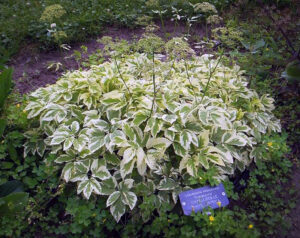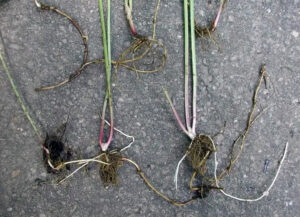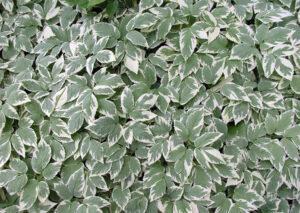By Erika Segerson-Mueller, DNR Invasive Plant Program Specialist, Oshkosh Service Center;
Erika.SegersonMueller@wisconsin.gov or 715-492-0391

A common garden ornamental, Bishop’s goutweed may be better known to home gardeners as “snow-on-the-mountain.” / Photo Credit: Leslie J. Mehrhoff, University of Connecticut, Bugwood.org
Introduced as an ornamental plant commonly planted in gardens, Bishop’s goutweed is a restricted invasive plant in Wisconsin under Invasive Species Rule NR40.
Also known by common names such as snow-on-the-mountain, bishop’s weed and goutwort, the variegated variety with white edges will probably look familiar to many gardening enthusiasts.
The genus and species name for Bishop’s goutweed (Aegopodium podagraria) reportedly has an etymology meaning “little goat feet” – a fitting name considering that goutweed escapes cultivation and spreads rapidly, choking out almost any plant in its path. This plant spreads vigorously by rhizomes, underground stems that grow horizontally and can produce new root systems. Rhizomes enable plants to survive unfavorable seasons underground and can allow plants to persist for many years.

Horizontal underground roots called rhizomes are to blame for the aggressive spreading of Bishop’s goutweed. / Photo Credit: Leslie J. Mehrhoff, University of Connecticut, Bugwood.org
Goutweed becomes problematic as the rhizomes entangle with the roots of other more desirable plants and can continue sprouting for years. Once entangled, the stems are difficult to remove without breaking off fragments that can easily sprout new plants.
Goutweed does well in the moist soil of garden beds, but it is also highly tolerant of shade and can invade closed-canopy forests. When it escapes cultivation, infestations can spread to neighboring natural areas via intentional planting or dumping of yard waste, including discarded plant fragments or rhizomes.
Once established, infestations are challenging to remove. This plant has the potential to persist for long periods. The dense patches formed by goutweed in forests displace native species, reduce species diversity and inhibit the establishment of conifers and other native tree species.
Identification
Goutweed is a creeping perennial with leaves divided into three groups of three leaflets. Leaflets can be ovate or cordate (heart-shaped) with toothed margins and are green or variegated green and white.

While variegated varieties are common, Bishop’s goutweed may adapt to shady environments by turning its leaves green. / Photo Credit: Leslie J. Mehrhoff, University of Connecticut, Bugwood.org
Interestingly, the variegated versions of the plant may adapt to shady environments. The leaves can become entirely green so that the plant can absorb more sunlight and produce more chlorophyll, giving it a survival advantage in locations where sunlight is harder to come by.
When in bloom, its flowers grow in white, flat-topped umbels (like umbrellas in shape). Flowering stems can reach up to three feet tall.
Control
Hand-pulling or digging goutweed is a largely unsuccessful control method. All rhizomes must be removed to ensure that the plant will not continue to spread because plant and root fragments can readily resprout. Recommended control is the use of a systemic herbicide, such as glyphosate. As with most invasive plant control, follow-up treatment will likely be required.
Black plastic tarps or sheeting can be used to cover the plant in early spring when leaves start emerging. Leaving the plant covered throughout the summer will prevent it from photosynthesizing and deplete its carbohydrate reserves.

The flowering stems of goutweed can reach three feet and grow in umbels. / Photo Credit: Leslie J. Mehrhoff, University of Connecticut, Bugwood.org
Native Alternatives
If you are looking for a plant to serve as an ornamental groundcover, there are excellent native plants that will also benefit pollinators and wildlife.
University of Wisconsin-Extension’s Horticulture department has a section of alternatives for Bishop’s goutweed on their Landscaping Alternatives for Terrestrial Invasive Flowers and Grasses page. Also, your local nursery will likely have a wealth of information and recommendations on native ground cover.
